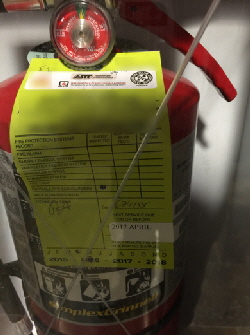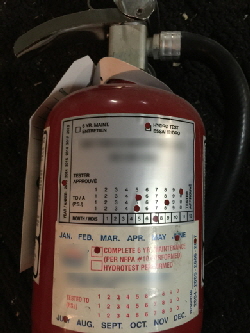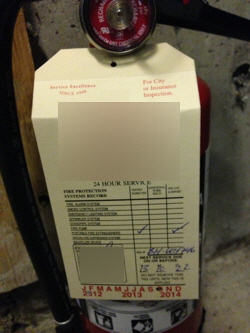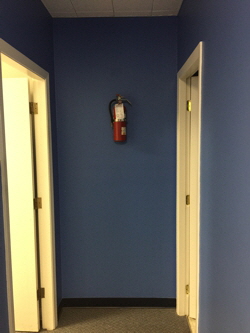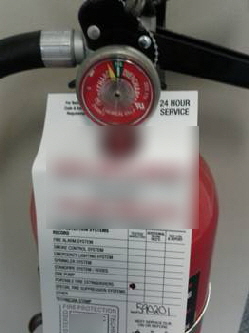EDITORIAL
|
||||||||||||||||||||||||||||||||
|
“We’ve all heard that a million monkeys banging on a THE FIRE EXTINGUISHER CERTIFICATION CIRCUS By Frank Kurz As I look back on the last ten years since www.firetechs.net first launched, I see a fire protection equipment service industry still very much in turmoil, with technicians across Canada continuing to perform substandard testing and inspection of vital building safety equipment and systems, even though many maintain membership in (and are certified through) two Canadian-based organizations charged with overseeing their education, professional practice, and something called ethics. There is a large amount of confusion and miss-information out there about fire extinguisher servicing, maintenance, and inspection. We’re going to try and shine some light on what fire protection equipment service technicians in CANADA can and can’t do (or more diplomatically, “should and shouldn’t do”). In British Columbia particularly, we have the unique benefit of an organization that’s responsible for certifying technicians that engage in the testing and inspection of building life safety equipment that isn’t limited to merely fire alarm systems. This would suggest that there is a higher degree of professional oversight extended to those individuals registered in, and participating under, the program’s auspices. The Applied Science Technologists and Technicians of British Columbia (ASTTBC) issues “endorsements” for these fire protection equipment and system categories: AL - Fire Alarm Inspection and Testing (to CAN/ULC-S536) EX - Portable Fire Extinguishers EM - Unit Emergency Lighting GS - Generator Systems FP - Fire Pumps SM - Smoke Control Systems WA - Water Based Extinguishing Systems (Fire Sprinklers) SP - Special Suppression Systems (includes Kitchen Suppression) CO - Kitchen Hood Cleaning Service As the headline of this article suggests, we’re going to focus on: Portable Fire Extinguishers We’re going to examine this discipline through the ASTTBC Fire Extinguisher Endorsement, for no other reason that their on-line competency guideline makes an excellent template for our discussion. What does the EX Endorsement actually confer on an RFPT (Registered Fire Protection Technician)? It’s not what many would view as anything truly earth-shattering:
The Competency section at http://fireprotection.asttbc.org/become-an-rfpt/rfpt-work-and-conditions/extinguisher/ lists several important points: “1. Conduct inspection and testing in conformance with applicable codes.” This statement, if not for the fact that it is further clarified in item 7 of the Section entitled Performance Factors, could very easily result in some pretty wild interpretations: “Conduct Annual Maintenance on portable fire extinguishers as required by NFPA 10 and maintain records as required.” What it really means is that RFPTs registered and working in the EX discipline are only qualified to perform TWO categories of testing designated in NFPA 10(2007). Keep in mind that these can only be performed if acceptable to the local jurisdictional authority (building owners and their designated agents should check the ASTTBC website for the list of British Columbia jurisdictions that have formalized a technician registration or certification requirement): |
|
|||||||||||||||||||||||||||||||
|
3.3.14 Extinguisher Inspection. 3.3.15 Extinguisher Maintenance. Why only these two categories? We’ll have to examine 3.3.4 Certified Person for the answer to that: “A person that has been certified by a recognized organization through a formal certification program or by an equipment manufacturer that has a certification program, that is acceptable to the authority having jurisdiction.” There are only TWO organizations that “Certify” individuals to perform actual service on extinguishers in Canada: Transport Canada and Warnock Hersey (Intertek). We’ve provided links to their websites below. In point of fact, to even maintain and operate a recharge facility, you are required to undergo regular inspections by designated agents of the two aforementioned organizations. In other words, the FACILITY has to be Certified as well as the individual that’s engaged in performing the actual work of recharging, six year maintenance, or hydrostatic testing. Now we do have to point out the key phrase in 3.3.4: “that is acceptable to the authority having jurisdiction”. An example where an uncertified shop could be acceptable would be in a jurisdiction that’s remote from any major centre which could viably support a properly certified shop. In this case, the AHJ can exercise some judgment as to whom he might want to consider to be acceptable. In major centres however (like the Lower Mainland and most Canadian cities), service companies that set up uncertified shops to recharge and service extinguishers (or do so from the back of a van) are in VIOLATION of NFPA 10 and the Canadian National Fire Code (British Columbia Fire Code). It is important to point out that ASTTBC IS NOT RECOGNIZED IN CANADA AS A FIRE EXTINGUISHER SERVICE CERTIFICATION AGENCY! ASTTBC has exhibited a long-standing policy of turning a blind eye to these practices, which has enabled these illegal operations to continue (and expand). We know of several locally operated uncertified shops that wholesale the recharging, six year maintenance and hydrostatic testing to smaller service companies whose management and technicians may not be familiar with the actual requirements. In light of the outcome of Complaint Case #16-09, it is doubtful we will see anything in the way of enforcement action, which means the public will continue to be exposed to an unacceptable level of risk. Who actually benefits from the illegal services performed by uncertified shops? Certainly not the public or the building owner. In point of fact an improperly conducted extinguisher recharge, six year maintenance or hydro-static is just as dangerous as not having these specialized services performed at all. We are, after all dealing with PRESSURIZED vessels (cylinders). The Competency section continues with: “2. Determine the class of fire by type.” Pretty basic knowledge practically anyone can find online (or by reading an extinguisher label). “3. Determine the occupancy classification.” Again, pretty basic knowledge to someone with a copy of the Standard. “4. Identify types of extinguishers and their operation.” See number 5. “5. Select the fire extinguishers for the applicable hazard.” So why do we continue to see ABC dry chemical extinguishers being tagged “OK” in kitchens (usually alongside a “K” Class unit). Why do we continue to see 2.5 lb. extinguishers passing as the sole extinguisher in a business (whether it’s an accountant’s, legal or medical office) through the application of an ASTTBC sanctioned inspection tag to which an RFPT has applied his seal and signature? The minimum rating for Light (Low) Hazard Occupancy is 2A. If you’re looking at the label on that 2.5 lb. ABC dry chemical extinguisher you’re about to tag, what classification is it? With a very few exceptions, it’s bound to be 1A-10BC, folks! “6. Distribute fire extinguishers as required.” Again, pretty basic, in that one of the fundamental concepts of even having an extinguisher is to make sure that the people passing through (or occupying) the area can actually SEE it. From NFPA-10(2007): 6.1.3.1 “Fire extinguishers shall be conspicuously located where they are readily accessible and immediately available in the event of fire.” 6.1.3.2 “Fire extinguishers shall be located along normal paths of travel, including exits from areas.” So why is it we continue to walk into buildings (some over twenty years old and which have been serviced by multiple RFPTs over the years) where extinguishers are MISSING in the common floor areas? They haven’t been stolen, or “walked away” (which is often the excuse we hear). They’ve NEVER BEEN INSTALLED! “7. Conduct inspections and annual maintenance.” What’s required in the way of basic tools for the Annual Maintenance? Do you need an accurate scale? What do you need to test conductivity on CO2 extinguisher hose assemblies? Do you have to unscrew the hose (or nozzle)? Examine the valve stem? PULL THE PIN? Replace the seal? Why is it we continue to see technicians, engaged in conducting the annual maintenance of these potentially life-saving devices, walking around the building with nothing more than a pocket full of tags, a pen, and a clipboard? Some don’t even bother taking the extinguisher out of the cabinet it’s in (or removing it from the hook), but simply swap the tag if the gauge is in the green. One question bears repeating: WHAT TOOLS DOES A TECHNICIAN NEED TO CONDUCT the Annual Maintenance of an extinguisher to ensure it’s operability in accordance with NFPA 10(2007) 3.3.15 and 7.3.2? THERE IS NOTHING in the way of direction on the ASTTBC website, so we’ll lay them out for you: Rubber mallet “8. Prepare a clear and accurate inspection and test reports (sic).” ASTTBC has forms for this, but for some reason, I’m still seeing strangely formatted reports being used. In point of fact, the technician often isn’t even involved in actually DELIVERING the final report. That’s usually left up to his employer’s service department representative (or manager). Personally, I don’t mind an unusually formatted report (in this instance) as long as all the pertinent details are provided that document the units proper maintenance and testing. “9. Communicate clearly with the owner or authorized agent.” If you’re not preparing the actual report, or dealing directly with the deficiencies because your company has adopted specific customer service procedures, how (and what) can you communicate effectively with the owner (or authorized agent)? “10. Communicate clearly with the Authority Having Jurisdiction.” Technicians aren’t allowed to say anything to an AHJ. That’s usually the job of the company’s service manager (a conversation that is often relegated to HIS sole discretion, as well). This is, of course, further complicated by the fact that most service managers can’t be held to account under the Practice Guidelines because many aren’t ASTTBC RFPTs. A corporate policy that REMOVES the technician from the equation must be carefully evaluated in the context of the Practice Guidelines. RFPTs must be able to ensure the appropriate follow-up is initiated whenever life safety equipment is flagged for additional work or RED TAGGED. Needless to say, it would be horribly unfair for an RFPT to receive a reprimand (or be dismissed) for following the Practice Guidelines in the performance of their professional duties. It would be our suggestion that you follow up with your supervisory (or manager), and ensure all the appropriate notifications are provided. Make sure you keep a log of your discussions, with date and time. The last thing any RFPT would want (or needs) is for a jurisdictional authority to file a complaint against them with ASTTBC for violating the Practice Guideline.
PORTABLE FIRE EXTINGUISHER MAINTENANCE AND INSPECTIONNFPA 10(2007) provides the procedure for performing the annual maintenance of all portable fire extinguishers in Clause 7.3.2: “Maintenance procedures shall include a thorough examination of the basic elements of a fire extinguisher and components of the electronic monitoring system and following the procedures detailed in the manufacturer’s service manual: (1) Mechanical parts of all fire extinguishers Clause 7.3.2.1.1: “Internal examination during annual maintenance shall not be required for nonrechargeable fire extinguishers, carbon dioxide fire extinguishers, or stored-pressure fire extinguishers, except for those types specified in 7.3.1.2.2.” (Note: 7.3.1.2.2 refers to Loaded Stream Charge type extinguishers.) Clause 7.3.2.1.2: “These fire extinguishers shall be thoroughly examined externally in accordance with the applicable items of 7.3.2(1).” Clause 7.3.2.2: “Seals or Tamper Indicators. At the time of the maintenance, the tamper seal of a rechargeable fire extinguisher shall be removed by operating the pull pin or locking device.” Clause 7.3.2.2.1: “After the applicable maintenance procedures are completed, a new listed tamper seal shall be installed.” Clause 7.3.2.2.2: “Tamper indications on non-rechargeable-type extinguishers shall not be removed.” Clause 7.3.2.3: “Boots, Foot Rings, and Attachments. All removable extinguisher boots, foot rings, and attachments shall be removed to accommodate thorough annual cylinder examinations.” Clause 7.3.2.4: “Physical Appearance. A visual examination of the extinguisher shall be made to examine for obvious physical damage, corrosion, or nozzle blockage, and to verify the operation instructions are present, legible, and facing forward and the WHMIS information is present and legible.” Clause 7.3.3: “Maintenance Record Keeping. Each fire extinguisher shall have a tag or label securely attached that indicates the month and year the maintenance was performed, identifies the person performing the work, and identifies the name of the agency performing the work.”
The periodic (monthly) inspection outlined in Clause 7.22 must also be performed by trained (not necessarily certified) personnel: “Periodic inspection or electronic monitoring of fire extinguishers shall include a check of at least the following items: (1) Location in designated place
SIX YEAR MAINTENANCE & HYDRO-STATIC TEST LABELS:On low pressure cylinders (your typical 5lb. ABC extinguisher), the intervals between the six year maintenance requirement and the hydro-static testing is six years. Six years from the date of manufacture, the extinguisher has to undergo an internal examination (oddly enough called the six year maintenance). Twelve years from the date of manufacture, the extinguisher is required to be hydro-statically tested. The cycle then repeats until the extinguisher is retired from service. Transport Canada and Warnock Hersey refer to this entire process as cylinder requalification. When either of these tests have been successfully completed, the extinguisher must be labelled with a special sticker that details the type of test performed (in the case of a hyro-static test, the label must also indicate the test pressure), the name of the service agency which performed the test, their certification number, and the name of the technician that conducted the test. The sticker has to meet certain requirements in that it has to be metallic polymer based and tamper-proof (it has to leave a mark on the cylinder if it’s removed). For high pressure cylinders (your typical CO2 extinguisher) a hydro-static test must be performed every five (5) years. High pressure cylinders have to be stamped (usually on the neck of the bottle or the skirt) with the date of the test and the certification number of the testing agency. In both cases another special label is also put on the cylinder’s neck. It’s called a “neck ring” and witnesses that the actual operating lever and valve assembly has been REMOVED and re-installed following a recharge service. Can a service provider swap the labels on the cylinder with an identical one that’s imprinted with their contact information? NO! The label that’s affixed to the cylinder following a successful test witnesses that the service has been performed by a CERTIFIED Cylinder Requalifier. If a technician performing the annual maintenance on a fire extinguisher can’t verify the valid registration status of the organization that performed the testing, HE/SHE MUST RED TAG THE CYLINDER! I would also go so far as to suggest that the recharge of an extinguisher should only be performed by a Certified Cylinder Requalifer. IMPORTANT NOTE: Transport Canada and Warnock Hersey (Intertek) maintain lists of Cylinder Requalifiers that have both valid and invalid registrations. This is actually a very important tool for any technician performing the annual Extinguisher Maintenance because it allows him/her to verify the shop’s Certification status on the date the six year maintenance or hydro-static test was conducted.
MALPRACTICE EXAMPLES:
IMPORTANT NOTE: Some of the extinguishers depicted in these photographs may not have been tagged on the site or at the location they’re mounted. In many instances, business owners bring their extinguishers to their closest fire protection equipment service agency where the annual maintenance is performed. It is important to identify these extinguishers as having not been tested in situ to mitigate the liability of (and a potential complaint against) the individual signing the tag. C Y A!
LOWER MAINLAND (BRITISH COLUMBIA) TRANSPORT CANADA APPROVED CYLINDER REQUALIFIERS:(Current to January 7th, 2017) 0777792 B.C. Ltd. (conducting business as Vancouver Fire and Security) A.W. Fireguard Supplies (1991) Ltd. ACME Fire and Safety Co. Ltd. DBC Marine Safety Systems Ltd. Fairlane Fire Prevention Limited Fraser Valley Fire Protection Ltd. Pacific Coast Fire Equipment (1976) Ltd. Royal City Fire Supplies Ltd. Wilhelmsen Safety, Inc.
You can read more concerning technician practices, testing methods, etc. by clicking on: Check out our EXTINGUISHER FAQ page, for more information! Testing forms and documentation can be found at:
AHJ Training Courses are being offered by two (2) Canadian national associations:
Canadian Fire Alarm Technician Certification:
Certified Fire Extinguisher Requalifiers (National):
Fire Protection Technicians (British Columbia only):
INTERESTED IN COMMENTING ON THIS ARTICLE? QUESTIONS? GOT A STORY? SOMETHING OF INTEREST AND/OR NOTE-WORTHY?
|
||||||||||||||||||||||||||||||||
The Fire Technicians Network
+1 (888) 340-3473
“We are not a professional union, but together, we are a union of professionals!”
What we’re all about!
We are not affiliated with ASTTBC, CFAA, CANASA, NFPA, NAFED, or NICET (although we encourage you to explore and objectively evaluate the benefits associated with supporting their individual efforts). Membership in the Fire Technicians Network is entirely voluntary. Are you up to the challenge of demonstrating your commitment to public safety and the highest standard of professional practice?
Copyright © 2007 - 2020 The Fire Technicians Network. All Rights Reserved
